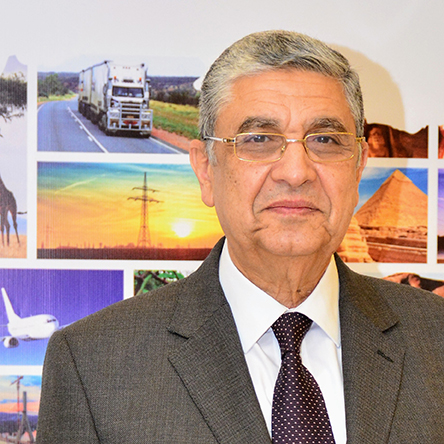A past of unreliable power supplies has been banished by a new commitment to the best technology and a bold renewable energy vision
The current Egyptian administration made the country’s energy deficit a key priority on taking over in 2014, a time when power cuts were the norm, as opposed to an exasperating exception. So far, it is delivering change at a rapid rate. Since 2015, the government says it has added 25.5 GW to Egypt’s installed capacity, almost doubling the previous level.
And the plan is to go further in terms of optimizing the distribution of that electricity, substituting carbon-based generation with renewable sources such as solar power, an infinitely abundant resource in an Egypt that wishes to welcome increased international investment to develop clean energy.
“Egypt is on the right track. One of the goals set by the president was to improve the energy system in the country, and that’s what we’re doing,” says Dr. Mohamed Shaker, Egypt’s Minister of Electricity and Renewable Energy, adding that one of the key reasons for the leap forward is that his administration is “ready for partnerships.”

Indeed, the flagship megaproject that has done the most to bring about Egypt’s energy transformation was the construction of three combined-cycle power plants, led by Siemens Egypt along with key local partners including Elsewedy and Orascom, adding 14.4 GW to the country’s installed capacity in a remarkably short 18-month timeframe. Dr. Shaker also emphasizes how partnering with a technological leader such as Siemens brings long-term benefits in performance and efficiency.
Now the immediate focus is on improving power distribution across the length and breadth of the country. Dr. Shaker says his ministry has almost tripled he transmission network to 6,000 kilometers and boosting substations and renewable energy projects away from the main cities to reach those last miles in rural Egypt. As solar and wind power projects are added to Egypt’s existing hydroelectricity capacity from the Nile, the country is approaching the government’s target of producing 20% of electricity from renewable sources by 2022. The subsequent milestone objective is to reach 42% by 2035.
“This is a big chance for the private sector. People believe in the success story of renewable energy in Egypt, and they are ready to invest in it,” says Dr. Shaker.
The solution lies in the desert, where Egypt has virtually limitless space for solar and wind plants, especially since only 7.7% of land is inhabited. The International Renewable Energy Agency reported last year that Egypt has the potential to take clean energy generation up to 53% of the national total by 2030, with solar photovoltaic (PV) seen close behind natural gas as Egypt’s main energy source in a decade from now.
Blazing the desert trail is the massive Benban Solar Park, the first utility-scale PV installation in Egypt, whose 7.2 million panels will add 1.8GW to the grid when it is completed in the coming months. The experience of constructing this sea of solar panels in southeastern Egypt – Benban is visible from space – has created a new and thriving technological sector almost overnight, spearheaded by companies such as Infinity Solar.
“The Benban Solar Park, considered the largest in the world, has resulted in the creation of great expertise and industry know-how in the Egyptian power sector,” says Mohamed Mansour, Infinity’s CEO.
Founded in 2014, Infinity has already reached a total installed capacity of 235.95 MW, having participated in the first and second rounds of Egypt’s feed-in tariff (FiT) programs, aimed at providing a flourishing market for renewables.
Target proportion of renewable electricity by 2022
Total investment in Benban Solar Park
To build Egypt Megaproject combined-cycle plants
Egypt’s reserves of natural gas (cubic feet)
Egypt’s proven reserves
of crude oil
“We were the first Egyptian firm to go through the entire process of developing and building a large-scale solar project: Infinity 50, jointly developed with our German partner ib vogt GmbH,” Mansour explains. The German tie-up is a key part of the Infinity story, with 85% of its financing needs on that breakthrough project coming from the Bayerische Landesbank.
Egypt’s growing entrepreneurial mesh now feeds off an improved energy environment, and thirsts for partnerships with international business leaders. Amr El Batrik, CEO of the Suez Industrial Development Company (SIDC), highlights the importance of two deals his company has already struck with Siemens, providing land for the engineering giant’s ventures.
But SIDC wants to become a bigger player in solar energy and the manufacturing of related technology. “We have the best silica sand, the best sun and a government that is encouraging renewable energy. I believe any German tech supplier or entrepreneur could come here, and we will take their hand and help them manufacture the equipment.”
Siemens’ power stations added 14.4GW of capacity to Egypt’s grid
On July 24, 2018, Siemens Egypt and its consortium partners opened the world’s largest combined-cycle power plants. Together, these stations now generate enough electricity to power Cairo four times over.
The megaproject broke world records for execution. Normally, building a 1,200MW single combined-cycle plant can take 30 months. Siemen’s megaproject, with a capacity of 14.4GW, was completed in just 27.5 months.
Since opening the plants, Egypt’s electricity situation has stabilized, for the public and businesses. “If you compare 2014 to the situation today, it has changed dramatically,” says Siemens Egypt CEO Emad Ghaly, remembering a major blackout that brought Egypt to a standstill. “We now have an abundance of electricity that will attract industries and investors to Egypt.